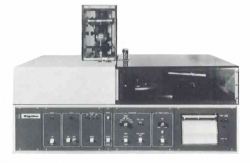 | ||
Miniflex is an X-ray diffraction (XRD) analytical measuring instrument produced by Rigaku. The current instrument is the fourth in a series introduced in 1973.
Contents
History
The Rigaku MiniFlex is historically significant in that it was the first commercial benchtop (tabletop) X-ray diffraction (XRD) instrument. When introduced in 1973, the original Miniflex was about one-tenth the size, and dramatically less expensive, than conventional X-ray diffraction equipment of the period. The original instrument, and its successor that was introduced in 1976, employed a horizontal goniometer with data output provided by an internal strip chart recorder.
The third generation device, introduced in 1995, was called Miniflex+. It provided a dramatic advance in x-ray power to 450 watts by operating at 30kV and 15mA as well as in the technology with computer control. Both the Miniflex+ and the current generation product employ a vertical goniometer and allow the use of an automatic sample changer. The current generation Miniflex II was introduced in 2006 and offers the advance of a monochromatic X-ray source.
Teaching
The simplicity and relatively low cost of the Miniflex line has led to its widespread use in colleges and universities to illustrate the physics behind X-ray diffraction. In addition to Chemistry and Physics, many Geology departments also employ the Miniflex to teach mineralogy.
Research
The MiniFlex is used in a wide range of industries as well as colleges and universities for research. Since 1973 over 12,000 patents and scientific papers have been published using data collected by a MiniFlex.
